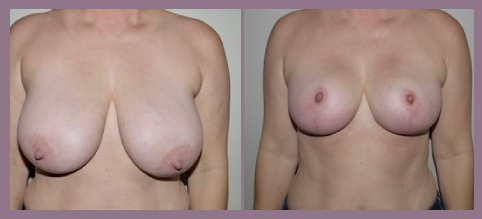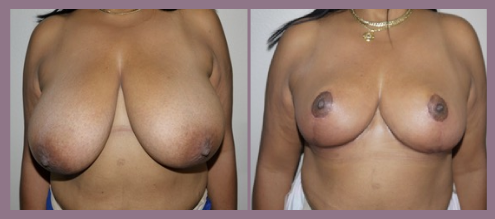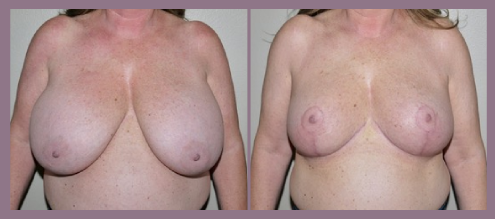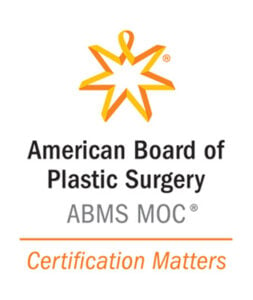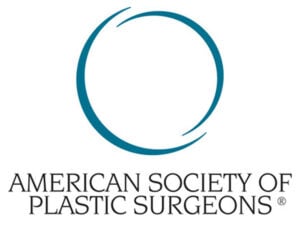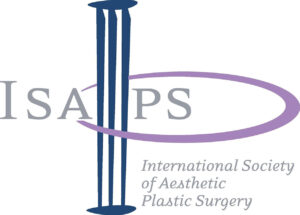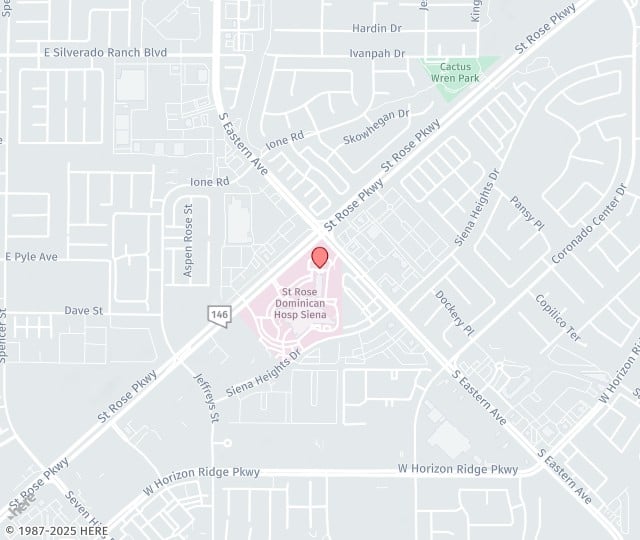Board-Certified Female Plastic Surgeon Specializing in Breast Reduction Surgery
Many women suffer from a condition called "macromastia," or excessively large breasts. Macromastia can be highly uncomfortable and even debilitating. It can cause physical problems like back and shoulder pain, plus trouble finding clothes that fit and getting unwanted attention. For women suffering from this condition, breast reduction surgery can be life-changing.
Here at Desert Hills Plastic Surgery Center in Henderson, Nevada, Dr. Hayley Brown is a renowned surgeon with extensive experience performing various breast surgeries. Call our office at 702-260-7707 to learn more and book your consultation!
What Is Breast Reduction Surgery?
Breast reduction surgery, also called "reduction mammaplasty," is a surgical procedure where a surgeon removes excess tissue from the breasts, tightens the skin, and repositions the nipple and areola. Breast reduction often results in a full breast lift effect, as well. Excess tissue weighs the breasts down, so when we remove it, the breasts naturally become lighter and perkier.
Types of Breast Reduction
There are two main types of breast reduction surgery: a vertical breast reduction and a full breast reduction. Both aim to remove excess tissue, tighten the skin, and reposition the nipple and areola to create a lighter, more lifted breast shape. The main difference lies in how much tissue is removed and how the breast is reshaped:
- A vertical breast reduction is typically done for those with small to moderate macromastia and good skin tone, focusing on removing tissue from the lower central part of the breast.
- A full breast reduction is better suited for moderate to severe macromastia and sagging, with tissue removed from all around the breast and more extensive reshaping.
How Much Does a Breast Reduction Cost?
Breast reduction costs begin at $20,000, depending on the complexity of the case. This includes surgeon fees, anesthesia fees, and surgery center fees.
Watch the video below to hear Dr. Brown discuss the cost of breast reduction surgery.
To get a customized cost estimate, please arrange a consultation with Dr. Brown. We also offer financing options through CareCredit and Prosper, both of which we can tell you more about at your consultation.
Am I a Candidate for Breast Reduction Surgery?
If you suffer from large breasts that cause problems in your daily life, you are probably a good candidate for a reduction mammaplasty.
Everyday problems that overly large breasts can cause include:
- Back, shoulder, and neck pain
- Difficulty exercising
- Ill-fitting clothes
- Unwanted attention when out in public
- Difficulty finding a bra that fits
- Pain from bra straps digging into shoulders
You may be an ideal candidate for a breast reduction procedure if you:
- Have large, sagging, heavy breasts
- Want a smaller bra size and lift of nipple
- Are uncomfortable or self-conscious about your breast size
- Have difficulty exercising
- Have pain in your back, shoulders, or neck due to the size of your breasts
- Are a non-smoker
- Are at a stable and healthy weight
What to Expect from Breast Reduction Surgery
Reduction mammaplasty is one of the most rewarding surgeries to perform, as it can improve a patient’s quality of life significantly. Back and neck pain improves, exercise becomes possible, clothes and bras start to fit better, and your entire self-image gets a boost.
Surgery
A reduction mammaplasty generally only takes two to three hours to perform. During the procedure, you'll be under general anesthesia. There should be no need to stay overnight following a breast reduction; you can go home as soon as the anesthesia has worn off and you feel ready.
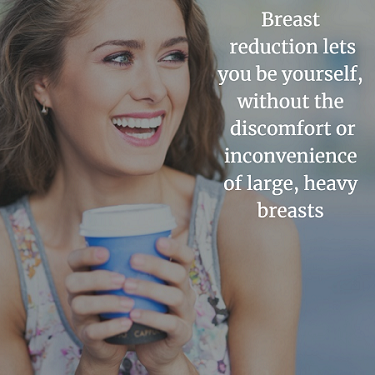
Asymmetry
It's important to remember that asymmetry is the natural state of breasts, and while improvements to symmetry can be made, the breasts usually will not be (and should not be) completely symmetrical after surgery.
Scarring
In addition, as with any surgery, there will be scars. Dr. Brown is highly skilled and can perform surgeries with the minimal amount of scarring possible, but you should still expect to have some.
Over time, the scars will fade, and you’ll be able to hide them even under a skimpy bikini. Most of our patients find that a few easily hidden scars are a small price to pay for a vast improvement in their quality of life.
Nipple Repositioning
At no point during your surgery is the nipple fully removed. It will remain attached to the underlying blood vessels, nerves, and ducts so as to retain function and sensation. However, if you are undergoing a very large reduction, it is possible that there will be some temporary changes to sensation. Please feel free to discuss this with Dr. Brown during your consultation.
Breast Reduction Post-Operative Care
Following the procedure, it's very important to follow all of Dr. Brown's postoperative care instructions. Each individual is different, but generally, you can expect the following:
- Breasts will be dressed in gauze and a surgical bra
- You may need drainage tubes; these are used about 70% of the time and are removed in four to six days
- We use absorbable sutures and will trim the small external knots in one or two weeks
- You'll have mild bruising and swelling
- No strenuous exercise for four weeks
- You can return to non-physical work within one to two weeks
- Sleep on your back for three to four weeks
- Bra support is required day and night for months for protection and to optimize shape as they heal
- Scars will initially be red and take at least one year to fade
Preparing for Breast Reduction Surgery
Proper preparation can help you have a smooth surgery and recovery process. Here are some steps to take before your breast reduction surgery:
- Stop smoking at least six weeks before surgery. Smoking can interfere with healing and increase the risk of complications.
- You may need to pause medications that thin your blood, such as aspirin, anti-inflammatory drugs, and certain supplements. Dr. Brown will provide you with a detailed list of medications to avoid.
- Have someone to drive you home after the procedure and assist you for the first few days. Plan to ask a friend or family member to help with everyday tasks while you recover.
- Set up a comfortable area in your home where you can rest. Have plenty of pillows to support your back, and keep necessary items like medications, snacks, and entertainment within easy reach.
- If you’re undergoing general anesthesia, you’ll need to fast before surgery. Dr. Brown’s team will provide you with specific instructions on when to stop eating and drinking the night before.
Why Choose Desert Hills Plastic Surgery Center?
Dr. Hayley Brown is a board-certified plastic surgeon who combines her medical expertise with an artistic touch to give her patients beautiful results. With over 20 years of experience, she is passionate about helping women feel more comfortable in their bodies. Whether you need relief from large breasts or are seeking a different cosmetic change, she wants to help you feel your best.
Dr. Brown works alongside her husband, Dr. Steve Brown, a board-certified anesthesiologist, to provide safe, smooth surgery. Together, they’ve created a caring office at Desert Hills Plastic Surgery Center. From the initial consultation to your recovery, Dr. Brown and her team will be here to support you.
Breast Reduction FAQs
How Much Time Do I Need To Take Off For Breast Reduction Surgery?
Watch the video below to hear more from Dr. Hayley Brown about taking time off from work for breast reduction surgery and recovery.
How Do I Know If I Need Breast Reduction?
The only person who can decide whether you need any procedure is you. Dr. Brown will make sure you are choosing a cosmetic procedure for yourself, not for someone else, or to try to fulfill other people’s expectations. As part of that goal, she makes sure you know what breast reduction can do for you based on the condition of your breasts and your concerns.
You may want to consider breast reduction if your bust size is distressing and impacting your quality of life. Many women with large breasts get unwanted attention from people who stare or make insensitive comments. Some may have been bullied when they were young women. It’s also very frustrating to not be able to find tops and dresses that fit your bust in a flattering way. All of these things should be considered as part of determining if you should get the surgery.
What Causes Extremely Large Breasts?
Many factors influence large breast size, including:
- Genetics
- Weight
- Hormonal changes
- Aging
Generally, genetics play the biggest role. The genes from both your mother’s and father’s families contribute to your breast size and other physical characteristics.
If you have always had large breasts, weight loss may have little to no effect on your breast size. A surgical reduction performed by Dr. Brown will permanently resize and reshape your breasts.
How Painful Is Breast Reduction?
The procedure itself is not painful because you will be anesthetized. You can expect some discomfort and soreness as you recover, but we will make sure you know how to manage it, either with prescribed painkillers or over-the-counter medications.
Soreness and stiffness around the breasts should get less and less intense over the next one to two weeks. These side effects will peak in the first one to three days. The vast majority of patients report that the recovery is manageable and well worth it.
How Many Cup Sizes Can You Go Down With Breast Reduction?
Many women go down one to three bra cup sizes after breast reduction. You could also find that your bra size doesn’t change after this procedure or changes in a way you didn’t expect.
In truth, bra size is not a reliable way to discuss breast size. Cups and bands vary by manufacturer and even by bra style. While we will discuss your desired size, there is no guarantee you’ll be exactly a 36B just because that is what you described.
Instead, Dr. Brown wants to make sure your new breast size flatters your body shape and proportions and meets your described expectations. Telling her what cup size you’re envisioning is a useful way to get on the same page, but shouldn’t be the only deciding factor. She wants you to look and feel amazing, so your initial consultation will be focused on helping you envision a new breast size that isn’t too small or too large.
Who Do You Talk to About Breast Reduction?
You talk to an experienced, board-certified, and compassionate plastic surgeon like Dr. Hayley Brown. Choosing any surgical procedure is a big decision. Your plastic surgeon should perform breast reduction routinely so that you can be sure they know what they are doing and that they provide great results consistently.
The founder of Desert Hills Plastic Surgery Center, Dr. Brown has been in private practice at our facility since the year 2000. She has performed thousands of breast reductions as well as other breast procedures. As such, she can provide valuable guidance and advice as you make this important decision about your body.
What Is Recovery Like Breast Reduction Surgery?
Following your breast reduction procedure, you will likely have some soreness for the next two to three weeks. To help you handle any discomfort during your first week in recovery, Dr. Brown may recommend pain medication.
Feeling sleepy or tired in the weeks following your surgery is very common. For most people, this tired feeling improves with each day of recovery. Any swelling you experience may last for up to four months following your procedure. Other common symptoms after breast reduction surgery include:
- Bruising
- Swelling
- Numbness
- Pain and tenderness
- Fatigue and weakness
- Rashes
- Skin tightness
To ensure a successful, complication-free recovery, follow Dr. Brown’s aftercare guidelines during your healing period.
Are There Any Risks With Breast Reduction Surgery?
Just like any other cosmetic surgery, breast reduction does come with several risks, including:
- Infection
- Asymmetry
- Excessive bleeding
- Anesthesia risks
- Blood clots
- Chronic pain
- Nerve pain
- Scarring
- Need for revision surgery
If you experience any of the above symptoms, contact the Desert Hills Plastic Surgery Center as soon as possible.
Can Breast Reduction Be Used for Gender Affirmation?
Yes, breast reduction can be a hugely beneficial transformation for gender-affirming surgery. Many transgender people often undergo breast reduction surgery to achieve gender affirmation. Commonly known as top surgery, many patients report that breast reduction allows them to feel a significant sense of gender euphoria, increase self-confidence, and improve comfortability in their own skin.
Can Breast Reduction Be Used for Breast Cancer?
Breast reduction has been shown to lower the risk of breast cancer. When there is less breast tissue, it's less likely that cancer will form. If you've been diagnosed with breast cancer, it's important to work closely with your oncologist to determine what next steps are the right fit for your needs. If you're concerned about breast cancer due to an increased risk based on your genetics or your family history, you may also benefit from a breast reduction.
What Is an Appropriate Age for a Breast Reduction?
Many patients in their 50s or 60s seek out breast reduction later in life due to hormonal changes or weight gain. However, young women are often also interested in breast reduction to improve their quality of life. To undergo a safe and effective breast reduction procedure, we recommend patients be at least 18 years of age.
Can Health Insurance Cover Breast Reduction?
While some insurance companies may offer coverage for symptomatic macromastia, the criteria are often strict. Typically, you must have documented symptoms like back, neck, or shoulder pain that haven't improved with conservative treatments. Many companies also require a minimum amount of breast tissue (e.g., 500 grams) to be removed for coverage.
Expect to pay for surgery, and do not expect financial reimbursement from your insurance company, or you are likely to be disappointed and unprepared. Dr. Brown does not take insurance for breast reduction surgery.
However, if you need breast reduction surgery for medical reasons, we can provide you with documentation and codes for insurance billing purposes. Ultimately, it is your responsibility to obtain reimbursement from your insurance company. Never expect full payment back from your insurance, only a small percentage of the overall cost is realistic.
If you need to go the insurance route, it may be preferable to call your insurance company to determine if there are plastic surgeons who service your insurance plan, and then consult with the plastic surgeon.
Insurance does not cover suction lipectomy or ultrasonically-assisted suction lipectomy (liposuction) as a sole method of treatment for symptomatic macromastia because such treatment is considered unproven in the treatment of symptomatic macromastia.
In our practice, we do see insurance covering the costs of prescription medications, preoperative testing and mammograms, and breast tissue pathology bills on a regular basis.
Can I Combine Procedures?
Breast reduction surgery is often performed in conjunction with other body contouring procedures, such as liposuction or tummy tuck, for a full body makeover. As long as you are healthy and at a good BMI, it may be possible to have these procedures done simultaneously. Talk to Dr. Brown about your options.
Is There an Ideal Time of Year to Schedule Breast Reduction Surgery?
While there’s no strict “best” time of year, many patients prefer to schedule their breast reduction during cooler months, as wearing compression garments can be more comfortable in cooler weather. It’s also common to plan surgery during a time when you can take time off from work or school and avoid any strenuous activities for a few weeks.
Will Weight Gain or Pregnancy Affect the Results of My Breast Reduction?
Yes, weight gain or pregnancy can affect your breast reduction results. Both can cause the breasts to enlarge or change shape, which may impact the outcome of your surgery. If you're planning significant weight changes or pregnancy, it’s a good idea to discuss timing with Dr. Brown.
Can I Breastfeed After Breast Reduction Surgery?
Breastfeeding after breast reduction is possible for some women, but it can be more difficult depending on the amount of tissue removed and how the procedure was performed. Dr. Brown can talk about your specific circumstances and the likelihood of being able to breastfeed after surgery during your consultation.
How Long Do I Have to Wait Before Resuming Sexual Activity After Breast Reduction?
Typically, you should wait at least two to three weeks before resuming sexual activity, depending on how your body is healing. It’s important to listen to your body and avoid any activity that causes discomfort or puts strain on your chest area.
Can Breast Reduction Surgery Affect My Posture?
Yes, breast reduction surgery can improve posture for many women. Large, heavy breasts can cause slouching or hunching, and after surgery, many patients find that standing up straighter and maintaining better posture becomes much easier as the physical burden on the back and shoulders is reduced.
Schedule Your Breast Reduction Consultation Today
If your breasts are so large they are a hindrance to your everyday life, breast reduction surgery may be the answer. Call Desert Hills Plastic Surgery Center in Henderson, NV at 702-260-7707 today to learn more about how Dr. Brown can help you with your macromastia.


